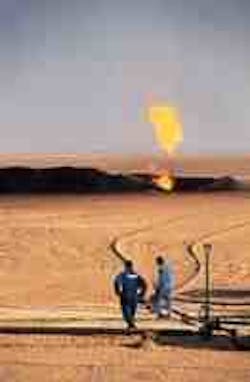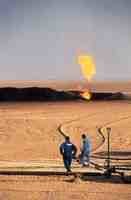Egypt western desert activity hits high gear
G. Alan PetzetExploration Editor
Exploration in Egypt's western desert is turning up large oil and gas reserves in several sub-basins.
Though not a threat to the Gulf of Suez's oil production dominance, the western desert's output is climbing. And gas production is also set to rise as more pipelines are built.
Apache Corp., Houston, largest independent in Egypt in terms of acreage held, has reported two discoveries on the Qarun concession southwest of Cairo, where it has five rigs running. Apache, which acquired Phoenix Resource Cos. Inc. last May, also has high expecations for the Khalda and Khalda Offset concessions farther west, and it recently acquired the northernmost concession in the Gulf of Suez.
Apache is pressing operations on the strength of cost recovery provisions in the Qarun and Khalda production sharing agreements that will enable the company to recoup more than $100 million, nearly all its E&D expenditures for the next few years, from expected production.
Meanwhile, Shell Egypt signed a contract at the end of September with Egyptian General Petroleum Corp. to develop 1.4 tcf of gas and a large volume of liquids on its 100% owned Obaiyed concession north of Khalda.
Shell Egypt is also working to prolong the life of its Badr el Din concession west of Qarun. It just received approval to add gas compression and drill four more wells at BED, which is producing 25,000-27,000 b/d of oil and condensate and 270-280 MMcfd of gas.
The Baker Hughes rig count for Egypt has ranged from 16-21 rigs/month from December 1995 through September 1996 vs. 17-18 for most of 1995 and 12-17 in 1994.
Unraveling geology
Four sub-basins in the northern part of the western desert each seem capable of producing 300 million bbl of proved reserves even without dense exploration, Apache said.
This general assessment is based on field size distributions and the similarity of geological characteristics in the four areas: Shushan in the Khalda area, Alamein south of El Hamra, Abu Gharadig south of Alamein, and Gindi southwest of Cairo.
Western desert exploration dates mainly from the 1950s, but the geology was slow to give up secrets. It still has fewer than 800 wells of all types in an area the size of Oklahoma-70,000 sq miles-where tens of thousands of wells have been drilled.
Cretaceous zones have been the big producers, and Jurassic pay was added at Khalda in the mid-1980s.
Shell said Deir el Sitta field on its Obaiyed concession was initially thought to be producing from the middle Jurassic Khatatba formation. Some uncertainty remains, but the pay zone at 4,000 m is now thought to be Mesozoic-Paleozoic. That could imply Triassic or even Permian production.
The Qarun concession has produced only from Cretaceous zones so far, said Steve Bell, Apache vice-president of Egypt operations.
"Elsewhere in the western desert there is production from sands that lie just above basement up to the base of the Tertiary section. We believe a lot more of the stratigraphic section is prospective on Qarun. Our current efforts are to extend some of our discoveries to the Jurassic levels while continuing to explore for the Cretaceous sandstones."
Qarun flow to grow
Production at Qarun, recently about 20,000 b/d, will rise to a gross 35,000 b/d around yearend after Apache's joint venture company, Qarun Petroleum Co., this month activates a 30 mile pipeline from Qarun field to the twin 42 in. Sumed oil pipelines.
Apache began producing Qarun oil in December 1995, trucking it to Tebbin for pipeline shipment to a refinery northeast of Cairo. Concurrently, construction began on production facilities, including two 350,000 bbl tanks, at a Sumed pump station at Dashur southeast of the Giza pyramids.
The Gindi basin had no commercial discoveries when Apache acquired an interest in the 1.9 million acre Qarun area in May 1993.
The Qarun 3 appraisal well in early 1995 had the largest onshore oil flow in Egypt-11,957 b/d. Today Apache has proved 75-80 million bbl of oil reserves in main, north, and southwest lobes of Qarun field. One of the largest western desert fields, Qarun now has 16 completed wells.
Cretaceous casinghead gas from a well in the A lobe of Qarun field is flared in Egypt's western desert southwest of Cairo. Photo courtesy of Apache Corp.
Qarun exploration
The northern Qarun discoveries lie among a series of northwest-southeast trends and produce 42° gravity oil from Cretaceous Kharita and Bahariya sandstones at 8,800-9,300 ft. There are indications of shallower Abu Roash pays in the Qarun field complex, and these are to be tested later this year.
The recent Wadi El Rayan discovery 35 miles south produced 25° gravity oil from 5,550-5,716 ft. That well, the western desert's southernmost producer, is about 19 km west of and on trend with an old Shell well that flowed about 250 b/d from Abu Roash. Apache will shoot seismic data in the area.
"Wadi el Rayan gives us some increased hope of different kitchen areas and charging mechanisms as well as for new play types on the southern portion of the block. We're becoming convinced of both Jurassic and Cretaceous kitchens in a number of areas in and around the Qarun concession," Bell said.
Apache holds Qarun 75%-25% with Seagull Energy Corp., Houston. Seagull recently acquired Global Natural Resources Inc.
Apache has fulfilled its Qarun work commitment and expects two seismic crews to continue full time there at least another year trying to increase the prospect inventory. It shot a 3D survey over Qarun A field 2 years ago and has already drilled at least one exploratory well to Jurassic.
The company has used 2D and 3D geophysics, subsurface and surface geology, Landsat, and source rock geochemistry in exploring Qarun, Bell said.
The Wadi el Rayan discovery is about a mile north of the 6.8 million acre East Beni Suef concession, on which Apache-Seagull 50-50 plan to drill the single commitment well in first quarter 1997.
Apache is on the lookout for more opportunities in Egypt. Early this year it acquired a 50% interest in the 460,000 acre Darag block, largest and northernmost Gulf of Suez concession.
Two of three Darag commitment wells are to be drilled in second half 1997. The block is considered exploratory acreage at the north edge of the Gulf of Suez basin.
Apache will conduct 2D seismic and a 110 sq km 3D bottom cable survey starting next month surrounding a subcommercial Total well that flowed more than 2,000 b/d of 31-33° gravity oil from Miocene Nukhul in the mid-1980s.
Khalda/Obaiyed gas
Shell and Repsol Exploracion Egipto SA plan to construct a 315 km gas pipeline from Shell's Obaiyed concession to Egypt's gas grid and a 640 mw power plant at Ameriya.
That pipeline, which is to pick up gas from the 300,000 acre Khalda concession, is to begin service in 1999. Khalda and the 2.1 million acre Khalda offset concession are held by Repsol 50%, Apache 40%, and Samsung Ltd. 10%.
Shell's volume will be about 300 MMcfd of gas. Repsol/Apache's Khalda volumes are expected to be 165 MMcfd. Khalda reserves are presently estimated at 255 bcf of gas 7.7 million bbl of oil and are growing.
Gas realizations are likely to be higher and more stable than in most U.S. contracts, Apache said.
Shell drilled five exploratory wells at Obaiyed during 1991-94, three of which were gas/condensate discoveries. Since 1994 it has drilled two successful appraisal wells and two more exploratory wells that effectively delineated the Deir el Sitta reservoir.
Drilling on Repsol/ Apache's Khalda concession has resulted in several gas/ condensate discoveries between existing oil fields in what were previously considered nonprospective gra- ben areas, Bell said. The pays are stratigraphically deeper in some cases, and this deeper gas/condensate province is practically unexplored.
Discoveries in August and September 1996 flowed 40 MMcfd of gas and 1,177 b/d of condensate and 49 MMcfd of gas and 2,119 b/d of condensate.
The companies have a large inventory of 50 prospects and leads on the Khalda and Khalda Offset blocks. The first well on the offset block is drilling, and a second will spud by yearend. The offset block is an area of tilted fault block plays in Cretaceous, Jurassic, and older rocks.
Khalda's oil production averages 32,000 b/d.
Meanwhile, Agip SpA recently reported that its nearby Meleiha Deep 1 discovery well flowed 9,800 b/d of oil and 1 MMcfd of gas.
Copyright 1996 Oil & Gas Journal. All Rights Reserved.

